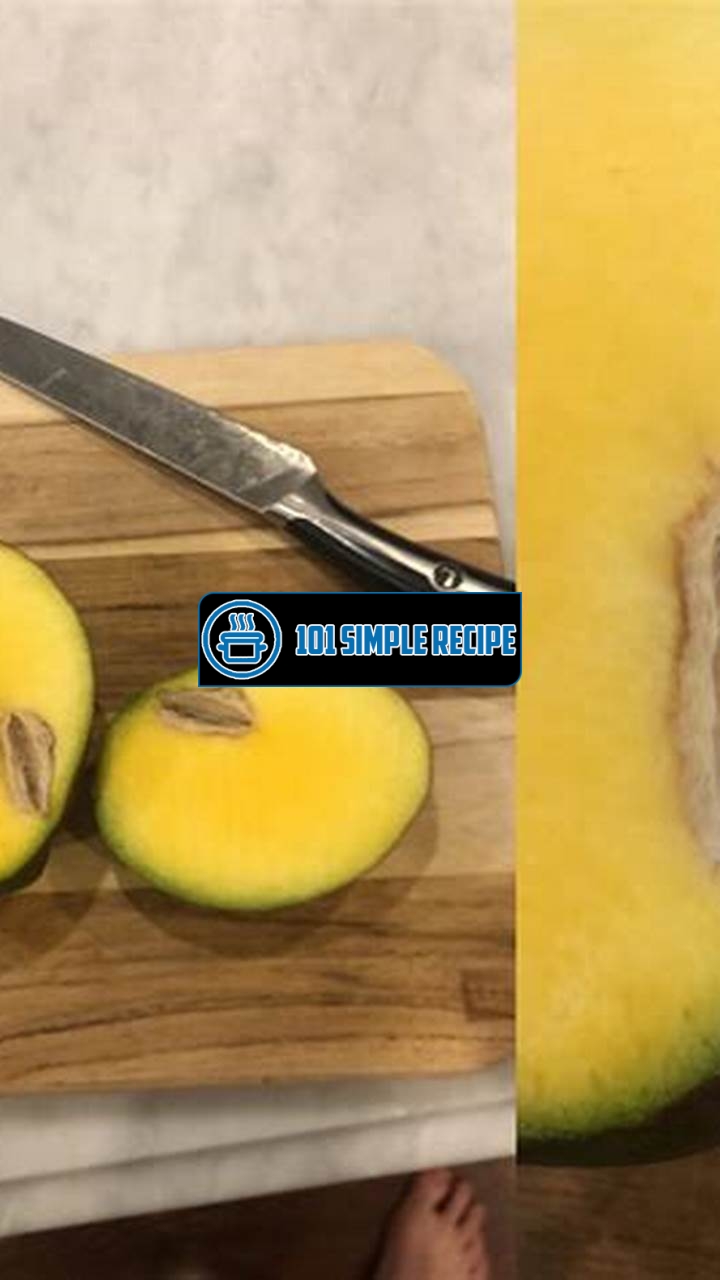Are you ready to embark on a mouthwatering adventure? Uncover the hidden treasure inside a young mango and experience a burst of tropical flavors like never before! This luscious fruit, often praised for its sweetness and juiciness, holds a world of delicious possibilities. Whether you enjoy it fresh or use it as a key ingredient in your favorite recipes, the young mango is sure to tantalize your taste buds and transport you to a paradise of flavors. So, without further ado, let’s delve into the enticing world of this exotic fruit and discover why it is a treasure worth exploring.

Exploring the Inside of an Unripe Mango
Discover the intricate details of an unripe mango, including its composition, taste, and potential uses.
The Anatomy of an Unripe Mango
An unripe mango, also known as a young or green mango, has a unique composition that sets it apart from its ripe counterpart. When you cut open an unripe mango, you’ll notice its firm and pale yellow to green flesh, which is quite different from the soft and juicy orange flesh of a ripe mango.
The flesh of an unripe mango is dense and fibrous, with a slightly tart taste. It contains a high concentration of starches and pectin, which give it a crisp and crunchy texture. The pectin content decreases as the mango ripens, resulting in a softer texture and sweeter taste.
As you continue to explore the inside of an unripe mango, you’ll come across a long and flat seed that takes up a significant portion of the fruit’s center. This seed is surrounded by the flesh, making it necessary to carefully slice or cut around it to access the edible portion of the mango.
It’s important to note that unripe mangoes may vary in size and shape, depending on the variety. However, their overall composition and taste remain relatively consistent.
Flavor Profile of an Unripe Mango
While the flavor of an unripe mango may not be as sweet as that of a ripe mango, it offers a unique taste experience. The tartness and subtle sweetness of an unripe mango create a refreshing and slightly tangy flavor.
The lack of intense sweetness allows the other flavors to shine through, making it an ideal ingredient for a variety of culinary creations. The mildly sour taste of an unripe mango pairs well with spicy, savory, and tangy flavors, adding a delightful contrast to dishes.
When incorporated into salads, salsas, or pickles, unripe mangoes provide a crispness and tang that enhance the overall flavor profile. Additionally, the subtle sweetness can balance out the heat from chili peppers or enhance the richness of creamy dressings or sauces.
The unique flavor of an unripe mango is not only enjoyable to the palate but also offers a culinary versatility that allows it to be used in both sweet and savory dishes.
Health Benefits of Unripe Mango
Unripe mangoes not only add a burst of flavor to your meals but also offer a range of health benefits. Here are a few reasons why you should consider including unripe mangoes in your diet:
- Rich in Vitamin C: Unripe mangoes are an excellent source of vitamin C, providing a significant boost to your immune system. Vitamin C also helps in collagen production, which contributes to healthy skin and wound healing.
- Source of Dietary Fiber: Fiber is essential for maintaining good digestion and preventing constipation. Unripe mangoes contain dietary fiber that aids in regular bowel movements and supports a healthy gut.
- Antioxidant Properties: Unripe mangoes contain antioxidants that help protect your cells from damage caused by free radicals. These antioxidants contribute to overall health and may help reduce the risk of chronic diseases.
- Low in Calories: If you’re watching your calorie intake, unripe mangoes are a great choice. They are low in calories and can be incorporated into a balanced diet without adding excessive calories.
Remember, while unripe mangoes have their own set of health benefits, it’s essential to consume them in moderation as part of a well-rounded diet.
Unripe mangoes are a hidden treasure waiting to be discovered. From their unique composition to their versatile flavor and health benefits, there’s more to this young fruit than meets the eye. So the next time you come across an unripe mango, embrace the opportunity to explore its potential and unlock its hidden treasures.
Picking and Ripening Unripe Mangoes
When it comes to enjoying the full potential of a mango, selecting and ripening unripe mangoes is key. By following proper techniques, you can uncover the hidden treasure inside a young mango.
Identifying and Selecting Unripe Mangoes
To start your mango adventure, you must first learn how to identify and select unripe mangoes. This is crucial as choosing the right mangoes will determine the success of your ripening process.
One way to identify an unripe mango is by its appearance. Unripe mangoes typically have a green color with hints of yellow. They may also have a firm texture and feel slightly heavier than fully ripe mangoes.
Another method to identify unripe mangoes is by their smell. Ripe mangoes have a sweet and fragrant aroma, while unripe ones lack this aroma and might have a grassy or sour scent.
When selecting unripe mangoes, make sure to avoid any bruised or damaged ones. Opt for mangoes with smooth skin and no soft spots as these indicators can give you an insight into the fruit’s ripeness.
Ripening Techniques for Unripe Mangoes
Once you’ve selected your unripe mangoes, it’s time to move on to the ripening techniques. There are several methods you can use to ripen your mangoes at home:
- Place them in a paper bag: This method involves keeping the mangoes in a paper bag at room temperature. The bag helps trap the natural gases produced by the fruit, which speeds up the ripening process.
- Use a ripening bowl: If you don’t have a paper bag, you can use a ripening bowl instead. Simply place the mangoes in a bowl and cover it with a lid or plastic wrap. This creates a warm and humid environment that promotes ripening.
- Wrap them in a newspaper: Wrapping unripe mangoes individually in newspaper can also hasten the ripening process. The newspaper traps heat and helps the fruit ripen faster.
- Utilize a ripe fruit: Another trick is to place an already ripe fruit, such as a banana or apple, alongside the unripe mangoes. Ripe fruits release ethylene gas, which triggers the ripening process in neighboring fruits.
Remember to keep a close eye on your mangoes as they ripen. Check them daily to ensure they are not overripe or spoiling.
Timing and Indicators of Ripeness
Knowing when your mangoes are ripe is essential to enjoy their full flavor and sweetness. The timing of the ripening process will depend on various factors such as the mango variety and the environment.
Typically, it takes around 2 to 7 days for unripe mangoes to ripen. Keep in mind that the mangoes will continue to ripen after you remove them from the ripening container, so it’s essential to monitor their progress closely.
When ripe, mangoes will have a slight give when gently squeezed. They will also develop a vibrant color, ranging from shades of yellow to orange or red, depending on the variety.
To ensure the best flavor, it’s recommended to refrigerate ripe mangoes after the ripening process. This will help preserve their freshness and sweetness.
By mastering the art of picking and ripening unripe mangoes, you can embark on a culinary journey filled with the mouthwatering flavors and aromas of this tropical fruit. Use these techniques to uncover the hidden treasure inside every young mango!
Unripe Mango Recipes
Unripe mangoes may not have the same sweetness as their ripe counterparts, but they possess a unique tangy flavor that can be harnessed to create a variety of mouthwatering dishes. Unlock the versatility of unripe mangoes by exploring these delicious recipes that will surely tantalize your taste buds and leave you craving for more.
Unripe Mango Salad
One fascinating way to savor the unripe mango is by turning it into a refreshing salad. With its vibrant colors and tangy taste, a mango salad is the perfect accompaniment to any meal. Start by peeling the mango and cutting it into thin strips. Add some diced cucumbers, bell peppers, and red onions for a refreshing crunch. For an added kick, dress the salad with a zesty dressing made from lime juice, olive oil, honey, and a sprinkle of chili flakes. The combination of flavors and textures will surely make your taste buds dance with delight.
Spicy Unripe Mango Chutney
If you’re a fan of spicy condiments, then this recipe is right up your alley. A spicy unripe mango chutney can add a burst of flavor to any dish, be it grilled meats, sandwiches, or even as a dip for your favorite snacks. To make this delectable chutney, finely chop the unripe mango and combine it with a medley of spices such as cumin, coriander, turmeric, and chili powder. Cook the mixture with a bit of oil until the mango softens. Finish it off with a squeeze of lemon juice and a sprinkle of salt. Your taste buds will thank you for the explosion of flavors.
Unripe Mango Smoothie
For a refreshing and healthy treat, look no further than an unripe mango smoothie. Packed with vitamins and nutrients, this smoothie is not just delicious but also nourishing for your body. Start by blending together the chopped unripe mango, a handful of spinach, a squeeze of lemon juice, a dollop of honey, and a splash of coconut water. The result is a vibrant green smoothie that is not only visually appealing but also incredibly tasty. Sip on this smoothie for a boost of energy and a refreshing start to your day.
Unlock the hidden treasure inside a young mango by exploring these delightful recipes. From the tangy goodness of a mango salad to the fiery flavors of a spicy mango chutney and the refreshing blend of an unripe mango smoothie, there’s no shortage of ways to enjoy this versatile fruit. So go ahead and try these recipes to discover the amazing flavors that lie within an unripe mango.
Unripe Mango in Traditional Cuisines
Unripe mango, though often overshadowed by its ripe, juicy counterpart, plays a significant role in traditional cuisines across the globe. From the tangy and spicy dishes of Thai cuisine to the vibrant flavors of Indian dishes, and even the tropical delights of Latin American dishes, unripe mango adds a unique twist to these culinary traditions.
Unripe Mango in Thai Cuisine
In Thai cuisine, unripe mango is commonly used to create the ever-popular dish known as “Som Tam.” This refreshing and zesty salad incorporates shredded unripe mango, along with other ingredients such as peanuts, tomatoes, Thai chilies, and fish sauce. The combination of sweet, sour, and spicy flavors create a tantalizing experience for your taste buds. ️
Additionally, unripe mango is used in Thai green curry, where it adds a hint of tartness to balance out the rich and creamy coconut milk. The unripe mango slices are added towards the end of cooking to retain their crispness and distinct flavor. The result is a harmonious blend of flavors that truly showcases the versatility of unripe mango in Thai cuisine.
Unripe Mango in Indian Cuisine
In Indian cuisine, unripe mango is a popular ingredient in both savory and sweet dishes. One of the most famous preparations is the traditional “Aam Panna” drink. It is made by boiling raw mangoes and blending them with sugar, spices, and mint leaves. The resulting refreshing and cooling beverage is perfect for beating the scorching summer heat.
Unripe mango is also used in various chutneys, pickles, and curries in Indian cuisine. Its tangy flavor complements the spices and herbs commonly used in Indian cooking. Whether it’s a spicy mango pickle or a tangy mango curry, unripe mango adds a burst of flavor that keeps you coming back for more.
Unripe Mango in Latin American Cuisine
Latin American cuisine features unripe mango in a range of dishes, particularly in countries like Mexico and the Caribbean. One popular dish is “ensalada de mango verde,” which is a green mango salad. The unripe mango is typically sliced into thin strips and mixed with lime juice, chili powder, and other seasonings. The resulting salad is crisp, tangy, and perfect for a light and refreshing meal.
Unripe mango is also a common ingredient in salsas and ceviche in Latin American cuisine. Its tartness adds a delightful twist to the fresh and vibrant flavors of these dishes. The contrasting flavors of the other ingredients, such as cilantro, tomatoes, and onions, create an explosion of taste that is unique to this regional cuisine.
In conclusion, unripe mango is a hidden treasure in the culinary world. Its versatility and distinct flavor make it a coveted ingredient in traditional cuisines around the globe. From Thai cuisine’s spicy salads to Indian cuisine’s cooling drinks and Latin American cuisine’s refreshing salsas, unripe mango adds a tangy twist that elevates these dishes to new heights. So, don’t overlook the potential of a young mango – peel it, slice it, and savor its hidden treasure!
Unripe Mango and Health
When you think of mangoes, you may picture ripe and juicy fruits that are bursting with sweetness. However, there is more to a mango than meets the eye. In fact, unripe mangoes, although unappetizing in appearance, can offer a hidden treasure trove of health benefits. In this article, we will explore the potential health benefits of consuming unripe mango and its impact on various health conditions.
Immune-Boosting Properties of Unripe Mango
Unripe mangoes, despite their sour taste, are packed with essential nutrients and antioxidants that can help boost your immune system. These nutrients include vitamin C, vitamin A, and various phenolic compounds.
Vitamin C is a powerful antioxidant that plays a crucial role in strengthening your immune system and fighting against infections and diseases. Consuming unripe mangoes can provide you with a good dose of vitamin C, helping to enhance your body’s defense mechanisms.
Additionally, unripe mangoes contain vitamin A, which is essential for maintaining healthy skin and mucous membranes. Vitamin A also supports the proper functioning of your immune system, helping to ward off illnesses and infections.
The phenolic compounds present in unripe mangoes possess strong antioxidant and anti-inflammatory properties. These compounds can help reduce oxidative stress in your body and support your immune system’s ability to combat harmful free radicals.
Unripe Mango for Digestive Health
Unripe mangoes are an excellent source of dietary fiber, which is essential for maintaining a healthy digestive system. Fiber adds bulk to your stool, promoting regular bowel movements and preventing constipation.
The fiber present in unripe mangoes can also help improve digestion and alleviate digestive issues such as indigestion, bloating, and acid reflux.
Moreover, unripe mangoes contain certain bioactive compounds like mangiferin and gallic acid, which possess antimicrobial properties. These compounds can help combat harmful bacteria in your gut, promoting a healthy gut microbiome.
Potential Anti-inflammatory Effects of Unripe Mango
Chronic inflammation is linked to several health conditions, including heart disease, diabetes, and certain types of cancer. Unripe mangoes may have potential anti-inflammatory effects due to the presence of compounds like mangiferin and quercetin.
Mangiferin, a bioactive compound found in unripe mangoes, has been shown to reduce inflammation markers in the body. It may help alleviate symptoms of inflammatory conditions such as arthritis.
Quercetin, another compound present in unripe mangoes, possesses anti-inflammatory and antioxidant properties. It may help reduce inflammation and oxidative stress, contributing to overall well-being.
In conclusion, while ripe mangoes are undeniably delicious, unripe mangoes offer a world of health benefits. From boosting your immune system to supporting digestive health and potentially reducing inflammation, incorporating unripe mangoes into your diet can be a smart and nutritious choice. So, don’t overlook those young mangoes at the market — they may just be the hidden treasure your body needs!
The inside of a unripe mango is an intriguing sight, with its vibrant green flesh and firm texture that holds the promise of sweet juiciness to come. As you slice open the unripe mango, you are greeted by a refreshing aroma that hints at the tropical flavors that will develop with time. The tightly packed fibers create a crisp and slightly tangy taste, offering a unique experience for your senses. It’s a reminder of the beauty and complexity that nature can bring. Thank you for joining us on this journey into the inside of a unripe mango. We hope you enjoyed this exploration and look forward to welcoming you back for more fascinating articles in the future. Until next time, happy reading!
Frequently Asked Questions
Here are some common questions about the inside of a unripe mango:
| No. | Questions | Answers |
|---|---|---|
| 1. | What does the inside of an unripe mango look like? | The inside of an unripe mango is vibrant green in color, with tightly packed fibers and a firm texture. |
| 2. | Does an unripe mango have any aroma? | Yes, an unripe mango has a refreshing aroma that hints at the tropical flavors that will develop as it ripens. |
| 3. | What is the taste of an unripe mango? | The taste of an unripe mango is crisp and slightly tangy, offering a unique flavor profile. |
| 4. | Are unripe mangos edible? | Unripe mangos can be eaten, but they are often preferred for cooking purposes or used in savory dishes rather than eaten raw. |
| 5. | How can I ripen an unripe mango? | To ripen an unripe mango, place it in a paper bag at room temperature for a few days until it reaches your desired ripeness. |
| 6. | Can I freeze unripe mango? | Yes, unripe mango can be frozen for future use. Simply peel, slice, and store it in an airtight container or freezer bag. |
Closing Thoughts
Thank you for taking the time to explore the inside of a unripe mango with us. We hope this article has provided you with a glimpse into the fascinating world of this tropical fruit. The unripe mango’s vibrant green flesh and unique taste offer a delightful experience for the senses. Remember to visit us again for more captivating insights and delightful articles. Until then, embrace the wonders of nature and keep exploring!
Jump to Recipe
Inside of a Unripe Mango

Discover the beauty and flavor of the inside of a unripe mango with this insightful article. Explore its vibrant green flesh, firm texture, and unique taste. Learn how to ripen an unripe mango and discover delicious recipes that make the most of this tropical fruit.
- 1 unripe mango
- Using a sharp knife, carefully slice the unripe mango lengthwise, avoiding the seed in the center.
- Observe the vibrant green flesh of the unripe mango, noting its firm texture and tightly packed fibers.
- Take a bite of the unripe mango to experience its crisp and slightly tangy flavor.
- If you prefer a sweeter taste, place the unripe mango in a paper bag at room temperature for a few days to ripen.
- Explore various recipes that use unripe mango, such as mango salad, mango salsa, or mango chutney.






